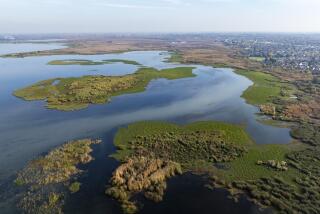Oil Spill Viewed as Threat to Proposed Pipeline Project
- Share via
Last week’s Granada Hills oil spill will jeopardize plans by an oil consortium to run a 130-mile pipeline from San Joaquin Valley and Santa Barbara oil fields to South Bay refineries, supporters and opponents of the project said Friday.
State, county and city officials predicted that Monday’s rupture of a corroded, 10-inch Mobil Oil Co. pipeline--which caused two traffic accidents and clogged a 22-mile stretch of Los Angeles waterways with 29,000 gallons of crude oil--will prompt intense opposition to the proposed Angeles Pipeline.
The project, a joint venture by Atlantic Richfield Co., Chevron Corp., Shell Oil Co. and Texaco Inc., would funnel 330,000 barrels of crude daily through a 30-inch pipeline running beneath streets in the San Fernando Valley and extending south through Los Angeles to five South Bay refineries.
The consortium hopes to begin constructing the $225-million project in mid-1987 and complete it by late 1988.
“When I saw the Granada Hills thing on the news I thought, ‘We’ve got a problem,’ ” said T. W. Shettler, environmental and permit manager for the consortium. “There’s a perception all of a sudden that crude oil pipelines are not safe.”
Shettler said he anticipates heated debate when the next in a series of public forums on the project is held later this month in Burbank. He also expects long and perhaps costly delays when the consortium seeks the necessary permits from the numerous governmental agencies along the proposed pipeline’s route.
“They’re going to say, ‘Hey, look what happened’ and ‘How can you tell the public it’s safe when they know what happened?’ ” Shettler said. “It will come up, and I’m going to have an answer. I just don’t know what it is, yet.
“We’re certainly not going to design it to fail. We’re not going to design it to leak.”
Dan Wolf, press secretary to Los Angeles County Supervisor Kenneth Hahn, said the spill “renewed concerns the supervisor already had about the project.” Hahn has asked the county Flood Control District to include a report on the Granada Hills spill in its report on the environmental impact of the Angeles Pipeline.
“We have seen a dramatic and disturbing example of what can happen when oil pipelines are permitted to be built in our communities,” Hahn said. “We are lucky it wasn’t worse.”
‘Greater Danger’
Hahn, noting that the Angeles Pipeline would be three times the diameter of the broken Mobil Oil pipe, said, “The proposed pipeline that would cut north and south through Los Angeles County would potentially pose an even greater danger, as hundreds of thousand of gallons of heated, heavy crude oil would be rushing under our streets seven days a week. I am very concerned about the environmental safety questions.”
City Councilman Hal Bernson, who also requested a report on the spill from the city fire and public works departments, said he expects the incident to intensify opposition to the project.
“I’d certainly be surprised if it didn’t,” Bernson said.
One of two routes proposed by the consortium would run the pipeline southerly along Foothill, Glen Oaks and Los Feliz boulevards in Los Angeles and adjacent to Western Avenue, Hawthorne Boulevard and Rosecrans Avenue in the South Bay. An alternative, westerly route under consideration would run a section of the pipeline along Balboa and Sepulveda boulevards.
Balboa Boulevard runs adjacent to Bull Creek, which was severely polluted when the Mobil Oil pipeline ruptured late Monday beneath Woodley Avenue near Nanette Drive, spilling crude oil into storm drains that empty into the creek.
Flows Into River
Work crews were unable to keep the oil from flowing into the Los Angeles River at the Sepulveda Dam Recreation Area and finally headed off the crude Tuesday afternoon near Dodger Stadium, about 22 miles from the break. State Department of Fish and Game Lt. Tim Goffa said about 20 ducks coated with crude oil were recovered from the creek and river, and by Friday two of them had died.
Rob Glushon, president of the city’s Environmental Quality Board, said a similar break in the Angeles Pipeline would be more harmful to wildlife because the type of crude oil generated from Santa Barbara offshore wells has a heavier concentration of sulfur and potentially toxic metals.
“I think what happened in Granada Hills kills the westerly alternative route, and it also damages the viability of the entire project,” Glushon said. “That was a minor spill, which still went 22 miles and destroyed some wildlife. If the same thing happened with a 30-inch pipe and the more toxic crude, the results would be disastrous. The damage to residents, businesses and parklands would be irreparable.”
Assemblyman Richard Katz (D-Sepulveda) also is opposed to the westerly alternative route along Balboa because of the nearby wildlife and the number of homes in the area, a spokeswoman said.
Improvements Cited
Ken Steele, deputy director for the California Department of Transportation, the state agency monitoring the project, said in the past 20 years there have been improvements in constructing and regulating the flow of crude through underground pipelines which make the process safer.
“The state of the art has improved,” Steele said. “There are wrappings to prevent corrosion and the welding in the seams are much stronger than they were 25 years ago.”
More to Read
Sign up for Essential California
The most important California stories and recommendations in your inbox every morning.
You may occasionally receive promotional content from the Los Angeles Times.













